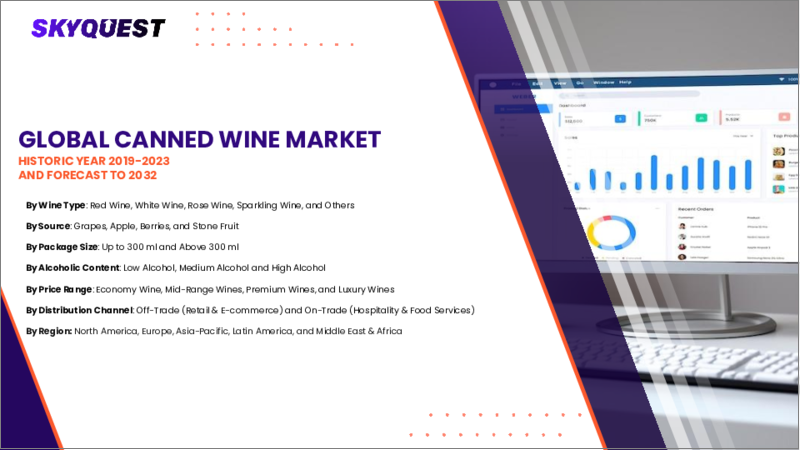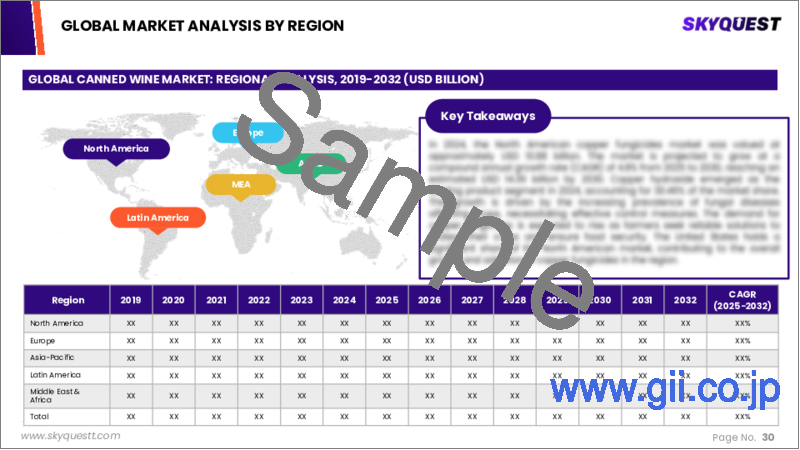|
|
市場調査レポート
商品コード
1636870
缶入りワイン市場規模、シェア、成長分析:製品タイプ別、パッケージサイズ別、アルコール度数別、流通チャネル別、地域別 - 産業予測 2025~2032年Canned Wine Market Size, Share, Growth Analysis, By Product Type (Sparkling Wine, Still Wine), By Package Size (Up to 300 ml, Above 300 ml), By Alcoholic Content, By Distribution Channel, By Region - Industry Forecast 2025-2032 |
||||||
|
|||||||
| 缶入りワイン市場規模、シェア、成長分析:製品タイプ別、パッケージサイズ別、アルコール度数別、流通チャネル別、地域別 - 産業予測 2025~2032年 |
|
出版日: 2025年01月16日
発行: SkyQuest
ページ情報: 英文 226 Pages
納期: 3~5営業日
|
全表示
- 概要
- 目次
缶入りワインの世界市場規模は、2023年に2億7,290万米ドルと評価され、2024年の3億865万米ドルから2032年には8億2,636万米ドルに成長し、予測期間(2025-2032年)のCAGRは13.1%で成長する見通しです。
忙しいライフスタイルの中で、利便性と費用対効果の高い選択肢を好む消費者が増えていることを背景に、持ち運び可能なシングルサーブ飲料の市場が急成長しています。特にCOVID-19以降、レディ・トゥ・ドリンク製品の需要が急増し、ビール、フレーバー麦芽飲料、サイダーの店外販売は2021年に25%増加します。缶入りワインは、携帯性と保冷のしやすさで人気を集めており、キャンプや釣りなどのアウトドア活動に最適です。さらに、消費者は持続可能な代替品にシフトしており、環境に優しいパッケージのオーガニックで栄養価の高い選択肢を好んでいます。アルミ缶はプラスチックに比べて軽量で安価であり、リサイクルも容易であるため、この分野の成長を牽引することになると思われます。アウトドアレクリエーションの動向は、便利なボトル入り飲料の需要をさらに高めています。
目次
イントロダクション
- 調査の目的
- 調査範囲
- 定義
調査手法
- 情報調達
- 二次データと一次データの方法
- 市場規模予測
- 市場の前提条件と制限
エグゼクティブサマリー
- 世界市場の見通し
- 供給と需要の動向分析
- セグメント別機会分析
市場力学と見通し
- 市場概要
- 市場規模
- 市場力学
- 促進要因と機会
- 抑制要因と課題
- ポーターの分析
主な市場の考察
- 重要成功要因
- 競合の程度
- 主な投資機会
- 市場エコシステム
- 市場の魅力指数(2024年)
- PESTEL分析
- マクロ経済指標
- バリューチェーン分析
- 価格分析
- ケーススタディ
- 規制情勢
- 顧客と購買基準の分析
- 原材料の分析
- スタートアップ分析
- 特許分析
- 貿易分析
缶入りワイン市場規模:製品タイプ別& CAGR(2025-2032)
- 市場概要
- スパークリングワイン
- スティルワイン
- 赤ワイン
- 白ワイン
- ロゼワイン
缶入りワイン市場規模:パッケージサイズ別& CAGR(2025-2032)
- 市場概要
- 最大300ml
- 300ml以上
缶入りワイン市場規模:アルコール度数別& CAGR(2025-2032)
- 市場概要
- 低アルコール
- 中アルコール
- 高アルコール
缶入りワイン市場規模:流通チャネル別& CAGR(2025-2032)
- 市場概要
- スーパーマーケットとハイパーマーケット
- コンビニエンスストア
- オンライン小売業者
- 専門店
- その他
- バー
- レストラン
缶入りワイン市場規模:地域別& CAGR(2025-2032)
- 北米
- 米国
- カナダ
- 欧州
- ドイツ
- スペイン
- フランス
- 英国
- イタリア
- その他欧州地域
- アジア太平洋地域
- 中国
- インド
- 日本
- 韓国
- その他アジア太平洋地域
- ラテンアメリカ
- ブラジル
- その他ラテンアメリカ地域
- 中東・アフリカ
- GCC諸国
- 南アフリカ
- その他中東・アフリカ
競合情報
- 上位5社の比較
- 主要企業の市場ポジショニング(2024年)
- 主な市場企業が採用した戦略
- 市場の最近の動向
- 企業の市場シェア分析(2024年)
- 主要企業の企業プロファイル
- 会社概要
- 製品ポートフォリオ分析
- セグメント別シェア分析
- 収益の前年比比較(2022-2024)
主要企業プロファイル
- E. & J. Gallo Winery(USA)
- Union Wine Company(USA)
- House Wine(USA)
- Underwood by Union Wine Company(USA)
- Nomadica(USA)
- Maker Wine(USA)
- Archer Roose(USA)
- West+Wilder(USA)
- Broc Cellars(USA)
- The Uncommon(UK)
- The Wine Group(USA)
- Dark Horse Wines(USA)
- Sofia by Francis Ford Coppola Winery(USA)
- Canned Wine Co.(Australia)
- Djuce(France)
- Les Dauphins(France)
- The Naked Grape(USA)
- Infinite Monkey Theorem(USA)
- Sofia Blanc de Blancs(USA)
- Ramona(USA)
結論と推奨事項
Global Canned Wine Market size was valued at USD 272.9 million in 2023 and is poised to grow from USD 308.65 million in 2024 to USD 826.36 million by 2032, growing at a CAGR of 13.1% during the forecast period (2025-2032).
The market for portable, single-serve beverages is rapidly growing, fueled by consumers' increasing preference for convenience and cost-effective options amid busy lifestyles. The demand for ready-to-drink products has surged, particularly post-COVID-19, with off-premise sales of beer, flavored malt beverages, and cider rising by 25% in 2021. Canned wine is gaining popularity for its portability and ease of cold storage, making it ideal for outdoor activities like camping and fishing. Additionally, consumers are shifting towards sustainable alternatives, preferring organic, nutritious options with eco-friendly packaging. Aluminum cans, being lightweight, cheaper, and easier to recycle compared to plastic, are set to drive growth in this sector. The trend towards outdoor recreation is further elevating the demand for convenient bottled beverages.
Top-down and bottom-up approaches were used to estimate and validate the size of the Global Canned Wine market and to estimate the size of various other dependent submarkets. The research methodology used to estimate the market size includes the following details: The key players in the market were identified through secondary research, and their market shares in the respective regions were determined through primary and secondary research. This entire procedure includes the study of the annual and financial reports of the top market players and extensive interviews for key insights from industry leaders such as CEOs, VPs, directors, and marketing executives. All percentage shares split, and breakdowns were determined using secondary sources and verified through Primary sources. All possible parameters that affect the markets covered in this research study have been accounted for, viewed in extensive detail, verified through primary research, and analyzed to get the final quantitative and qualitative data.
Global Canned Wine Market Segmental Analysis
Global Canned Wine Market is segmented by Product Type, Package Size, Alcoholic Content, Distribution Channel and Region. Based on Product Type, the market is segmented into Sparkling Wine and Still Wine. Based on Package Size, the market is segmented into Up to 300 ml, and Above 300 ml. Based on Alcoholic Content, the market is segmented into Low Alcohol, Medium Alcohol and High Alcohol. Based on Distribution Channel, the market is segmented into Supermarkets & Hypermarkets, Convenience Stores, Online Retailers, Specialty Stores and Others. Based on Region, the market is segmented into North America, Europe, Asia Pacific, Latin America and Middle East & Africa.
Driver of the Global Canned Wine Market
One of the key drivers of the Global Canned Wine market is its convenience. The canning format offers consumers a practical and portable packaging option, making it particularly suitable for outdoor activities, picnics, and social events. This lightweight and easily transportable beverage eliminates the need for traditional accessories like wine glasses or corkscrews, allowing for a hassle-free drinking experience on the go. As a result, canned wine has gained popularity among those looking for a more accessible way to enjoy their favorite drinks while traveling or engaging in leisure activities. This trend reflects a growing demand for convenient, ready-to-drink wine options.
Restraints in the Global Canned Wine Market
One of the key restraints affecting the global canned wine market is the prevailing quality perception among consumers. Many individuals still link canned wine with inferior quality, which hinders its growth potential and acceptance in the mainstream market. This perception poses a challenge for brands aiming to promote canned wine as a viable alternative to traditional bottled options. However, there is potential for change in this mindset as an increasing number of premium canned wines become available, which could lead to a gradual shift in consumer attitudes and greater market acceptance over time.
Market Trends of the Global Canned Wine Market
The Global Canned Wine market is poised for significant growth, driven by evolving consumer preferences that favor convenience and portability over traditional packaging. As lifestyles become increasingly fast-paced, the demand for ready-to-drink options continues to surge, particularly among millennials and working professionals who value the ease of enjoying quality wine on-the-go. This trend is reinforced by the appeal of canned wine's eco-friendly packaging and diverse flavor offerings that cater to a range of palates. As a result, the canned wine market is anticipated to flourish, reflecting a fundamental shift in how consumers approach wine consumption in various settings.
Table of Contents
Introduction
- Objectives of the Study
- Scope of the Report
- Definitions
Research Methodology
- Information Procurement
- Secondary & Primary Data Methods
- Market Size Estimation
- Market Assumptions & Limitations
Executive Summary
- Global Market Outlook
- Supply & Demand Trend Analysis
- Segmental Opportunity Analysis
Market Dynamics & Outlook
- Market Overview
- Market Size
- Market Dynamics
- Drivers & Opportunities
- Restraints & Challenges
- Porters Analysis
- Competitive rivalry
- Threat of substitute
- Bargaining power of buyers
- Threat of new entrants
- Bargaining power of suppliers
Key Market Insights
- Key Success Factors
- Degree of Competition
- Top Investment Pockets
- Market Ecosystem
- Market Attractiveness Index, 2024
- PESTEL Analysis
- Macro-Economic Indicators
- Value Chain Analysis
- Pricing Analysis
- Case Studies
- Regulatory Landscape
- Customer & Buying Criteria Analysis
- Raw Material Analysis
- Startup Analysis
- Patent Analysis
- Trade Analysis
Global Canned Wine Market Size by Product Type & CAGR (2025-2032)
- Market Overview
- Sparkling Wine
- Still Wine
- Red Wine
- White Wine
- Rose Wine
Global Canned Wine Market Size by Package Size & CAGR (2025-2032)
- Market Overview
- Up to 300 ml
- Above 300 ml
Global Canned Wine Market Size by Alcoholic Content & CAGR (2025-2032)
- Market Overview
- Low Alcohol
- Medium Alcohol
- High Alcohol
Global Canned Wine Market Size by Distribution Channel & CAGR (2025-2032)
- Market Overview
- Supermarkets & Hypermarkets
- Convenience Stores
- Online Retailers
- Specialty Stores
- Others
- Bars
- Restaurants
Global Canned Wine Market Size & CAGR (2025-2032)
- North America (Product Type, Package Size, Alcoholic Content, Distribution Channel)
- US
- Canada
- Europe (Product Type, Package Size, Alcoholic Content, Distribution Channel)
- Germany
- Spain
- France
- UK
- Italy
- Rest of Europe
- Asia Pacific (Product Type, Package Size, Alcoholic Content, Distribution Channel)
- China
- India
- Japan
- South Korea
- Rest of Asia-Pacific
- Latin America (Product Type, Package Size, Alcoholic Content, Distribution Channel)
- Brazil
- Rest of Latin America
- Middle East & Africa (Product Type, Package Size, Alcoholic Content, Distribution Channel)
- GCC Countries
- South Africa
- Rest of Middle East & Africa
Competitive Intelligence
- Top 5 Player Comparison
- Market Positioning of Key Players, 2024
- Strategies Adopted by Key Market Players
- Recent Developments in the Market
- Company Market Share Analysis, 2024
- Company Profiles of All Key Players
- Company Details
- Product Portfolio Analysis
- Company's Segmental Share Analysis
- Revenue Y-O-Y Comparison (2022-2024)
Key Company Profiles
- E. & J. Gallo Winery (USA)
- Company Overview
- Business Segment Overview
- Financial Updates
- Key Developments
- Union Wine Company (USA)
- Company Overview
- Business Segment Overview
- Financial Updates
- Key Developments
- House Wine (USA)
- Company Overview
- Business Segment Overview
- Financial Updates
- Key Developments
- Underwood by Union Wine Company (USA)
- Company Overview
- Business Segment Overview
- Financial Updates
- Key Developments
- Nomadica (USA)
- Company Overview
- Business Segment Overview
- Financial Updates
- Key Developments
- Maker Wine (USA)
- Company Overview
- Business Segment Overview
- Financial Updates
- Key Developments
- Archer Roose (USA)
- Company Overview
- Business Segment Overview
- Financial Updates
- Key Developments
- West + Wilder (USA)
- Company Overview
- Business Segment Overview
- Financial Updates
- Key Developments
- Broc Cellars (USA)
- Company Overview
- Business Segment Overview
- Financial Updates
- Key Developments
- The Uncommon (UK)
- Company Overview
- Business Segment Overview
- Financial Updates
- Key Developments
- The Wine Group (USA)
- Company Overview
- Business Segment Overview
- Financial Updates
- Key Developments
- Dark Horse Wines (USA)
- Company Overview
- Business Segment Overview
- Financial Updates
- Key Developments
- Sofia by Francis Ford Coppola Winery (USA)
- Company Overview
- Business Segment Overview
- Financial Updates
- Key Developments
- Canned Wine Co. (Australia)
- Company Overview
- Business Segment Overview
- Financial Updates
- Key Developments
- Djuce (France)
- Company Overview
- Business Segment Overview
- Financial Updates
- Key Developments
- Les Dauphins (France)
- Company Overview
- Business Segment Overview
- Financial Updates
- Key Developments
- The Naked Grape (USA)
- Company Overview
- Business Segment Overview
- Financial Updates
- Key Developments
- Infinite Monkey Theorem (USA)
- Company Overview
- Business Segment Overview
- Financial Updates
- Key Developments
- Sofia Blanc de Blancs (USA)
- Company Overview
- Business Segment Overview
- Financial Updates
- Key Developments
- Ramona (USA)
- Company Overview
- Business Segment Overview
- Financial Updates
- Key Developments





